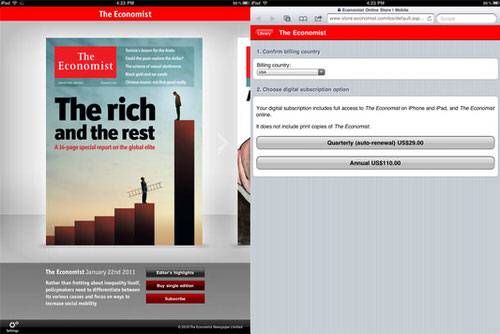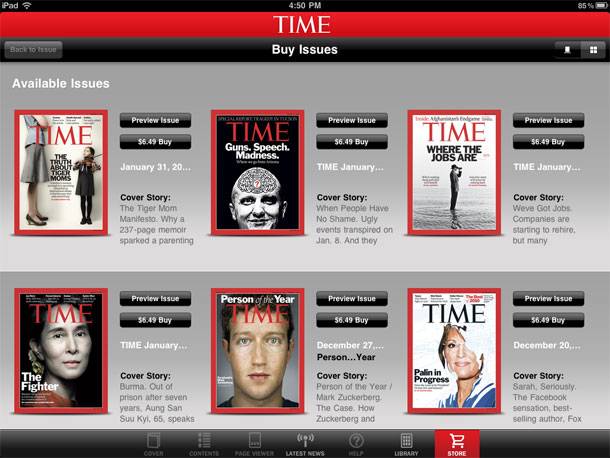Every Monday evening we’ll be looking at the latest in new media trends. The series is named after the title of one of my favorite books, The New New Thing by Michael Lewis. In that book, published in 1999, Lewis chronicled the dot com era startups that were attempting to re-make various industries. A similar upheaval is currently underway in traditional media – newspapers, magazines and book publishing. All are being radically overhauled by Web startups and tech giants like Apple and Google.

In today’s post, we look at Apple’s challenge to the magazine and newspaper industries. In particular, Apple is preparing a new subscription model for the App Store that will position it as a powerful intermediary between media publishers and consumers.
Rumors of a subscription model for the App Store surfaced soon after the iPad was launched last year. Traditional magazines such as TIME showed immediate interest in the iPad, as a way to sell more magazines. Speculation was rife over Apple’s desire to be the gateway for consumers to subscribe to these publications.
See Also:
However subscription functionality was withheld by Apple, which to this day does not allow publishers to directly bill their subscribers from within iTunes. Publishers have been forced instead to sell individual editions on the iPad, (poorly) mimicking the functionality of buying an app.
All was not lost for publishers wanting to pursue the subscription model, however. Apple left open the gate for publishers to re-direct users to their own websites in order to process subscriptions, which publishers such as The Economist duly did.
In the left screenshot above, users are prompted to subscribe from within The Economist’s iPad app. However when clicked, the subscribe button opens a browser window outside of the iPad (see image to the right).

Another option for publishers was to use Zinio, an online magazine shop which offers iPad subscriptions to magazine titles like Rolling Stone and National Geographic. However the Zinio user experience is not quite as good as a native iPad app like Wired. Plus Zinio is an intermediary for publishers too – and as an iPad app itself, it’s as reliant on Apple as the publishers are.
Apple can control apps like Zinio. But allowing publishers to directly control their iPad revenue stream even outside of their iPad apps proved troublesome to Apple, so it finally moved to close the gate a few months ago. All new apps that offer a subscription outside of iTunes now risk rejection by the App Store. Apps that currently re-direct users to their own websites to subscribe have until the end of June this year to shut off that functionality. Apple has asked app developers to “please submit an update that uses the In App Purchase API for purchasing content, by June 30, 2011.”
So Apple is about to move into the subscription business in a big way. It’s expected to launch this model via a partnership with Rupert Murdoch’s News Corp, which is developing an iPad-based newspaper called The Daily. There have been production delays with The Daily, though, which has forced Apple to delay its launch too.
Who is Apple’s subscription service good news for? Undoubtedly for consumers, who just want an easy and inexpensive way to subscribe to their favorite newspapers and magazines on the iPad.
Apple currently forces publishers like TIME to sell individual issues, instead of having a cost-effective subscription option.

For publishers it’s a double-edged sword. On the one hand it will lead to increased readership, but on the other hand publishers will cede control over the subscription process and accompanying reader data to Apple. In its upcoming subscription model, Apple may or may not decide to share user data to publishers (it hasn’t so far, on individual issue sales). Also publishers will have little control over what revenue cut Apple will take, although it’s likely to be the same 30% it takes on the App Store.
Frédéric Filloux argues in Monday Note that Apple’s subscription service will be of much more benefit to small publishers, who will accept a relatively high revenue cut by Apple in exchange for outsourcing the technicalities of subscription.
For big publishers however, there remains a lot of fear over the control Apple will have over them. In a recent New York Times article, publishers like Hearst appeared to be pinning their hopes on alternative tablets – Android, Kindle and others. That seems like a vain hope though, as Apple has built up a considerable early lead in the tablet market for magazines.
When Apple does launch its subscription model alongside Rupert Murdoch’s The Daily, overall it will be a good thing for consumers and publishers alike. But it also means that another content industry will fall under Apple’s dictatorial governance, alongside the music business.









